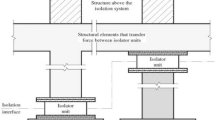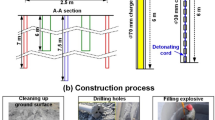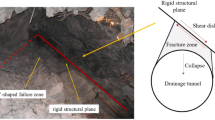Abstract
In the past few years, many countries have suffered severely from the attacks in form of blasts and other terrorist activities. These attacks have caused a major loss to infrastructure, human lives as well as economic losses. When the explosive occurs intentionally, it is called blast and if the explosive explodes accidentally then it an explosion. In India, the blast resistant design of structures is categorized as explosion above ground, IS 4991 (Indian standard criteria for blast resistant design of structures for explosions above ground, New Delhi, India, 1969) and underground blasts, IS 6922 (Indian Standard criteria for safety and design of structures subject to underground blast, New Delhi, India, 1973). In addition, different international codes and regulations namely NATO (Department of Defense in Structures to resist the effects of accidental explosions, UFC 3-340-02, DC, United States of America, Washington, 2008), FEMA (NATO in Manual of NATO safety principles for the storage of NATO ammunition and explosives, AC/258-D/258, Bonn, Germany, 1993) and DOD (FEMA 428 in Primer to design safe school projects in case of terrorist attacks, Federal Emergency Management Agency, United States of America, 2003) provide guidelines to mitigate blast induced effects on structures. A brief sketch on the development of blast pressure time history generated from detonation of manmade explosions is discussed. Factors affecting the intensity of blast load and its effects on various structural components both experimentally and analytically are also summarized. Theoretical and empirical approaches proposed by various researchers for the prediction of realistic blast load are also studied. The review also includes blast mitigation strategies proposed by various investigations for an improved structural performance against blast. The studies presented in the literature review are broadly categorized under two sections namely studies on air and surface blast loading and studies on underground mine blast loading.




Similar content being viewed by others
References
BIS (Bureau of Indian Standards) IS 4991 (1969) Indian standard criteria for blast resistant design of structures for explosions above ground. New Delhi, India
BIS (Bureau of Indian Standards) IS 6922 (1973) Indian Standard criteria for safety and design of structures subject to underground blast. New Delhi, India
Department of Defense (2008) Structures to resist the effects of accidental explosions, UFC 3-340-02. DC, United States of America, Washington
NATO (1993) Manual of NATO safety principles for the storage of NATO ammunition and explosives, AC/258-D/258. Bonn, Germany
FEMA 428 (2003). Primer to design safe school projects in case of terrorist attacks, Federal Emergency Management Agency, United States of America.
Shirbhate PA, Goel MD (2021) A critical review of blast wave parameters and approaches for blast load mitigation. Arch Comput Methods Eng 28(3):1713–1730
Held M (1983) Blast waves in free air. Propellants, Explos, Pyrotech 8(1):1–7
Dharaneepathy MV, Keshava Rao MN, Santhakumar AR (1995) Critical distance for blast resistant design. Comput Struct 54(4):587–595
Smith PD, Hetherington JG (1994) Blast and ballistic loading of structures. Butterworth-Heinemann, Oxford
Chock JMK (1999) Review of methods for calculating pressure profiles of explosive air blast and its sample application (Doctoral dissertation, Virginia Tech).
Lam N, Mendis P, Ngo T (2004) Response spectrum solutions for blast loading. Electron J Struct Eng 4(5):28–44
Ngo T, Mendis P, Gupta A, Ramsay J (2007) Blast loading and blast effects on structures—an overview. Electron J Struct Eng 7:76–91
Bajic Z, Bogdanov J, Jeremic R (2009) Blast effects evaluation using TNT equivalent. Sci Tech Rev 3(4):50–53
Hussein AT (2010) Non-linear analysis of SDOF system under blast load. Eur J Sci Res 45(3):430–437
Sochet I, Gardebas D, Calderara S, Marchal Y, Longuet B (2011) Blast wave parameters for spherical explosives detonation in free air. Open J Saf Sci Technol 1(2):31
Goel MD, Matsagar VA, Gupta AK, Marburg S (2012) An abridged review of blast wave parameters. Def Sci J 62(5):300–306
Kinney GF, Grahm KJ (1985) Explosive shocks in air. Springer, Berlin
Karlos V, Solomos G (2013) Calculation of blast loads for application to structural components. Publications Office of the European Union, Italy, JRC Technical Reports, Luxembourg
Rigby SE, Tyas A, Bennett T, Clarke SD, Fay SD (2014) The negative phase of the blast load. Int J Prot Struct 5(1):1–19
Ullah A, Ahmad F, Jang HW, Kim SW, Hong JW (2017) Review of analytical and empirical estimations for incident blast pressure. KSCE J Civ Eng 21(6):2211–2225
Krauthammer T, Altenberg A (2000) Negative phase blast effects on glass panels. Int J Impact Eng 24(1):1–17
Iqbal J (2009) Effects of an external explosion on a concrete structure. Doctoral dissertation, University of Engineering and Technology, Taxila-Pakistan.
Jayasooriya R, Thambiratnam D, Perera N, Kosse V (2009) Response and damage evaluation of reinforced concrete frames subjected to blast loading. In 34th conference on our world in concrete & structures, Hotel Park Royal, Singapore, 16-18 August (2009).
Moon N (2009) Prediction of blast loading and its impact on buildings. M.Tech. Thesis, National Institute of Technology, Rourkela, Orissa, India.
Hwang YS (2010) Three dimensional responses of a steel structure under blast loads. Doctoral dissertation, University of Southern California.
Goel MD, Matsagar VA, Gupta AK (2011) Dynamic response of stiffened plates under air blast. Int J Prot Struct 2(1):139–155
Raparla HB, Kumar RP (2011) Linear analysis of reinforced concrete buildings subjected to blast loads. Indian Concrete Institute, ICI Journal 1–16.
Anandavalli N, Lakshmanan N, Iyer NR, Prakash A, Ramanjaneyulu K, Rajasankar J, Rajagopal C (2012) Behaviour of a blast loaded laced reinforced concrete structure. Def Sci J 62(5):284–289
Draganic H, Sigmund V (2012) Blast loading on structures. Tech Gazette 19(3):643–652
Kadid A, Nezzar B, Yahiaoui D (2012) Nonlinear dynamic analysis of reinforced concrete slabs subjected to blast loading. Asian J Civil Eng (Building And Housing) 13(5):617–634
Matsagar V (2013) Materials for sacrificial blast wall as protective structure. Proc Indian Natl Sci Acad 79(4):717–723
Jain S, Tiwari R, Chakraborty T, Matsagar V (2015) Dynamic response of reinforced concrete wall under blast loading. Indian Concrete J 89(8):27–41
Xu J, Chengqing Wu, Hengbo Xiang YuSu, Li Z-X, Fang Q, Hao H, Liu Z, Zhang Y, Li J (2016) Behaviour of ultra-high-performance fibre reinforced concrete columns subjected to blast loading. Eng Struct 118:97–107
Hashemi SK, Bradford MA, Valipour HR (2017) Dynamic response and performance of cable-stayed bridges under blast load: effects of pylon geometry. Eng Struct 137:50–66
Pourasil MB, Mohammadi Y, Gholizad A (2017) A proposed procedure for progressive collapse analysis of common steel building structures to blast loading. KSCE J Civ Eng 21(6):2186–2194
Shin J, Lee K (2018) Blast performance evaluation of structural components under very near explosion. KSCE J Civ Eng 22(2):777–784
Sakula J (1997) The design of building facades for blast resistance. In: Proceedings of the international conference on building envelope systems and technologies, ICBEST, p. 97.
Miyamoto HK, Taylor D (1999) Structural control of dynamic blast loading using passive energy dissipaters. In: Structural engineers association of California, SEAOC Convention, 299–317.
Hayes Jr JR, Woodson SC, Pekelnicky RG, Poland CD, Corley WG, Sozen M, Mahoney M, Hanson RD (2004) Earthquake resistance and blast resistance: a structural comparison. In: Proceedings of the 13th world conference on earthquake engineering, Vancouver, British Columbia, Canada, 1–6.
Koccaz Z, Sutcu F, Torunbalci N (2008) Architectural and structural design for blast resistant buildings. In: The 14th world conference on earthquake engineering, Beijing, China.
Smith PD (2010) Blast walls for structural protection against high explosive threats: a review. Int J Prot Struct 1(1):67–84
Huang YN, Whittaker AS (2009) Response of conventional and base isolated nuclear power plants to blast loading. In: 20th international conference on structural mechanics in reactor technology (SMiRT 20), Espoo, Finland, 9–14.
Wu C, Hao H (2005) Numerical study of characteristics of underground blast induced surface ground motion and their effect on above-ground structures. Part I. Ground motion characteristics. Soil Dyn Earthq Eng 25(1):27–38
Goel MD, Matsagar VA (2014) Blast resistant design of structures. Pract Period Struct Des Constr 19(2):04014007
Burrell R, Aoude H, Saatcioglu M (2014) Response of SFRC columns under blast loads. J Struct Eng 141(9):04014209
Zhang R, Phillips BM (2015) Performance and protection of base- isolated structures under blast loading. J Eng Mech 142(1):04015063
Mohebbi M, Dadkhah HD (2017) Performance of semi-active base isolation systems under external explosion. Int J Struct Stab Dyn 17(10):1750112
Kangda MZ, Bakre S (2019) Positive phase blast effects on base isolated structures. Arab J Sci Eng 44(5):4971–4992
Jangid RS (1996) Seismic response of sliding structures to bidirectional earthquake excitation. Earthquake Eng Struct Dynam 25(11):1301–1306
Rao PB, Jangid RS (2001) Performance of sliding systems under near-fault motions. Nucl Eng Des 203(2–3):259–272
Jangid RS (2005) Computational numerical models for seismic response of structures isolated by sliding systems. Struct Control Health Monit 12(1):117–137
Kulkarni JA, Jangid RS (2003) Effects of superstructure flexibility on the response of base-isolated structures. Shock Vib 10(1):1–13
Soni DP, Mistry BB, Jangid RS, Panchal VR (2011) Seismic response of the double variable frequency pendulum isolator. Struct Control Health Monit 18(4):450–470
Remennikov A, Carolan D (2006) Blast effects and vulnerability of building structures from terrorist attack. Aust J Struct Eng 7(1):1–11
Siskind DE, Stagg MS, Kopp JW, Dowding CH (1980) Structure response and damage produced by ground vibration from surface mine blasting, 1–4. US Department of the Interior, Bureau of Mines, New York
Rigas F, Ioannis S (1999) Amplification effects of soil stratification on ground stress waves. J Geotech Geoenviron Eng 125(7):611–614
Manual T, TM5-855-1 (1986) Fundamentals of protective design for conventional weapons, Chapter 5, Headquarters. U.S. Department of the Army, Washington, D.C., pp 1–27
Hinman, E. E. (1989). ‘‘Shock response of buried structures subject blast.’’ Proc., ASCE Spec. Conf. on Struct. for Enhanced Safety and Phys. Security, 191–202.
Carvalho EML, Battista RC (2003) Blast-induced vibrations in urban residential buildings. Proc Inst Civ Eng Struct Build 156(3):243–253
Wu C, Lu Y, Hao H, Lim WK, Zhou Y, Seah CC (2003) Characterization of underground blast-induced ground motions from large-scale field tests. Shock Waves 13(3):237–252
Wu C, Hao H, Lu Y (2005) Dynamic response and damage analysis of masonry structures and masonry infilled RC frames to blast ground motion. Eng Struct 27(3):323–333
Wu C, Hao H (2005) Numerical study of characteristics of underground blast induced surface ground motion and their effect on above-ground structures. Part II. Effects on structural responses. Soil Dyn Earthq Eng 25(1):39–53
Wu C, Hao H (2005) Numerical study of characteristics of underground blast induced surface ground motion and their effect on above-ground structures. Part I. Ground motion characteristics. Soil Dyn Earthquake Eng 25(1):27–38
Erten O, Konak G, Kizil MS, Onur AH, Karakus D (2009) Analysis of quarry-blast-induced ground vibrations to mitigate their adverse effects on nearby structures. Int J Min Miner Eng 1(4):313–326
Ataei M (2010) Evaluation of blast induced ground vibrations from underground excavation at Karoun 3 area. Min Technol 119(1):7–13
Mesec J, Kovač I, Soldo B (2010) Estimation of particle velocity based on blast event measurements at different rock units. Soil Dyn Earthq Eng 30(10):1004–1009
Mohamed AM, Mohamed AEEA (2013) Quarry blasts assessment and their environmental impacts on the nearby oil pipelines, southeast of Helwan City, Egypt. NRIAG J Astron Geophys 2(1):102–115
Kumar R, Choudhury D, Bhargava K (2013) Prediction of blast-induced vibration parameters for soil sites. Int J Geomech 14(3):04014007
Kumar R, Choudhury D, Bhargava K (2016) Determination of blast-induced ground vibration equations for rocks using mechanical and geological properties. J Rock Mech Geotech Eng 8(3):341–349
Wu C, Hao H, Lu Y, Sun S (2004) Numerical simulation of structural responses on a sand layer to blast induced ground excitations. Comput Struct 82(9):799–814
Tian L, Li ZX (2008) Dynamic response analysis of a building structure subjected to ground shock from a tunnel explosion. Int J Impact Eng 35(10):1164–1178
Mondal PD, Ghosh AD, Chakraborty S (2013) Performance of NZ systems in the mitigation of underground blast induced vibration of structures. J Vib Control 20(13):2019–2031
Mondal PD, Ghosh AD, Chakraborty S (2014) Control of underground blast induced vibration of structures using fluid viscous damper. J Vib Eng Technol 2(1):27–33
Majumder R, Ghosh AD (2015) Performance study of a SMA bracing system for control of vibration due to underground blast induced ground motion. Adv Struct Eng. Springer, New Delhi, pp 393–404
Mondal PD, Ghosh AD, Chakraborty S (2016) Performance of various base isolation systems in mitigation of structural vibrations due to underground blast induced ground motion. Int J Struct Stab Dyn 17(4):1750043
Mondal PD, Ghosh AD, Chakraborty S (2017) Control of underground blast induced building vibration by shape‐memory‐alloy rubber bearing (SMARB). Struct Control Health Monit 24(10).
Kangda MZ, Bakre S (2019) Response control of adjacent structures subjected to blast-induced vibrations. Proc Inst Civ Eng Struct Build 172(12):902–921
Kangda MZ, Bakre S (2019) Performance evaluation of moment-resisting steel frame buildings under seismic and blast-induced vibrations. J Vib Eng Technol 8(1):1–26
Brode HL (1955) Numerical solutions of spherical blast waves. J Appl Phys 26(6):766–775
Sadovsky MA (2004) Mechanical effects of air shockwaves from explosions according to experiments. Geophysics and physics of explosion (ed. MA Sadovsky), Nauka Press, Moscow.
Henrych J, Major R (1979) The dynamics of explosion and its use, vol 569. Elsevier, Amsterdam
Kingery CN, Bulmash G (1984) Airblast parameters from TNT spherical air burst and hemispherical surface burst. US Army Armament and Development Center, Ballistic Research Laboratory
Baker WE (1973) Explosions in air, Vol 1. University of Texas Press, Austin.
Lin X, Zhang YX, Hazell PJ (2014) Modelling the response of reinforced concrete panels under blast loading. Mater Des 1980–2015(56):620–628
Abladey L, Braimah A (2014) Near-field explosion effects on the behaviour of reinforced concrete columns: a numerical investigation. Int J Prot Struct 5(4):475–499
Algassem O, Li Y, Aoude H (2019) Ability of steel fibers to enhance the shear and flexural behavior of high-strength concrete beams subjected to blast loads. Eng Struct 199:109611
Kiakojouri F, Sheidaii MR (2019) Numerical analysis of steel I-core sandwich panels subjected to multiple consecutive blast scenarios. Iran J Sci Technol Trans Civ Eng 43(1):371–382
Zheng C, Kong XS, Wu WG, Xu SX, Guan ZW (2018) Experimental and numerical studies on the dynamic response of steel plates subjected to confined blast loading. Int J Impact Eng 113:144–160
Kumar P, Shukla A (2011) Dynamic response of glass panels subjected to shock loading. J Non-Cryst Solids 357(24):3917–3923
Sahu DK, Davis R, Sarkar P, Patro SK (2018) Comparison of energy dissipation devices in response reduction of blast-induced vibration of buildings.
Kangda MZ, Bakre S (2021) Performance of linear and nonlinear damper connected buildings under blast and seismic excitations. Innov Infrastruct Solut 6(2):1–19
Dutta SC, Majumder R (2019) Shape memory alloy (SMA) as a potential damper in structural vibration control. In: Advances in manufacturing engineering and materials (pp 485–492). Springer, Cham
Shahriari A, Birzhandi MS, Zafarani MM (2021) Seismic behavior, blast response and progressive collapse of RC structures equipped with viscoelastic dampers. Soil Dyn Earthq Eng 143:106643
Dadkhah H, Mohebbi M (2019) Performance assessment of an earthquake-based optimally designed fluid viscous damper under blast loading. Adv Struct Eng 22(14):3011–3025
Wierschem NE, Hubbard SA, Luo J, Fahnestock LA, Spencer BF, Michael McFarland D, Dane Quinn D, Vakakis AF, Bergman LA (2017) Response attenuation in a large-scale structure subjected to blast excitation utilizing a system of essentially nonlinear vibration absorbers. J Sound Vib 389:52–72
Silva PF, Lu B (2007) Improving the blast resistance capacity of RC slabs with innovative composite materials. Composites B 38(5–6):523–534
Lori G, Morison C, Larcher M, Belis J (2019) Sustainable facade design for glazed buildings in a blast resilient urban environment. Glass Struct Eng 4(2):145–173
Gebbeken N, Warnstedt P, Rüdiger L (2018) Blast protection in urban areas using protective plants. Int J Prot Struct 9(2):226–247
Author information
Authors and Affiliations
Corresponding author
Ethics declarations
Conflict of interest
The author declares that he has no known competing financial interests or personal relationships that could have appeared to influence the work reported in this paper.
Additional information
Publisher's Note
Springer Nature remains neutral with regard to jurisdictional claims in published maps and institutional affiliations.
Rights and permissions
About this article
Cite this article
Kangda, M.Z. Blast Protection Techniques: A Review. Arch Computat Methods Eng 29, 3509–3529 (2022). https://doi.org/10.1007/s11831-021-09704-5
Received:
Accepted:
Published:
Issue Date:
DOI: https://doi.org/10.1007/s11831-021-09704-5




